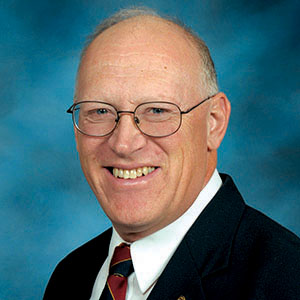Kansas Profile – Now That’s Rural: Ron Evans, astronaut
July 20, 2022
By Ron Wilson, director of the Huck Boyd National Institute for Rural Development at Kansas State University
From open plains to outer space, Ron Evans experienced a remarkable journey. He was a Kansan who played a record-setting role in the United States’ final mission to the moon.
![]() The year was 1972. NASA had planned for a series of moon missions but budget limitations cancelled additional lunar flights. Instead, NASA changed the focus of future flights to the space shuttle and lower earth orbital flights.
The year was 1972. NASA had planned for a series of moon missions but budget limitations cancelled additional lunar flights. Instead, NASA changed the focus of future flights to the space shuttle and lower earth orbital flights.
At right: Ron Evans | Download this photo
Meanwhile, NASA moved forward with what would be the final deep space manned mission to date. It was named Apollo 17. The person selected to serve as command module pilot on Apollo 17 was a Kansan, Ron Evans.
Evans was born in the rural northwest Kansas community of St. Francis, population 1,329 people. Now, that’s rural.
Evans had two younger brothers, Larry and Jay. When Larry came down with liver cancer, the family relocated to Topeka to be closer to treatment. Unfortunately, Larry passed away in 1951.
Brother Jay played football for K-State. By his senior year, he was team captain and was second in the Big 8 in yards receiving. Jay went on to play in the NFL for the Denver Broncos.
Jay left pro football to join the Marines during the Vietnam war era and became one of the most highly decorated Marines of the Vietnam War. He received the combat medal, Navy Cross, Silver Star, three Purple Hearts, three Air Medals, Combat Gold Wings and three personal citations from the Vietnamese government, one of which was the Cross of Gallantry with four gold stars -- the equivalent to the Congressional Medal of Honor from the U.S.
Ron chose to study electrical engineering at the University of Kansas. In order to finance his studies, he joined the Navy ROTC program. Part of that program involved a tour of a naval air station in Texas, which inspired him to become a naval aviator. He became a fighter pilot and flew more than 100 missions during the Vietnam War. He served on the aircraft carrier USS Ticonderoga.
In 1966, Ron Evans joined the astronaut corps. He became a member of the backup crew for Apollo 14 and, in 1972, was selected as the command module pilot of Apollo 17. This would prove to be the last manned flight to the moon.
As command module pilot, he remained on the command module while his two fellow crew members made a landing on the surface of the moon. They spent three days on the lunar surface and deployed numerous scientific instruments before rejoining Evans on the command module for the trip back home to earth.
During the flight back to earth, Evans conducted a spacewalk to retrieve materials from the service module. Upon leaving the space capsule and seeing the vastness of space, he uttered words which truly sound like a Kansas kid: “Hot diggety dog,” he said.
His spacewalk is one of only three to occur in deep space and holds the record as the spacewalk performed at the greatest distance from any planetary body. He also holds the record for the most time spent by any human in lunar orbit.
After the command module splashed down in the Pacific Ocean, the astronauts were retrieved by the crew of a Navy ship. It was none other than the USS Ticonderoga, the very ship where Evans had served six years before.
Evans worked on the development of the space shuttle before retiring from the Navy and NASA. He worked in industry before suffering a stroke and passing away suddenly in his sleep in 1990.
Evans was one of 24 astronauts to have flown to the moon and one of 12 to have flown to the moon without landing on it. He remains the last person in history to have orbited the moon.
From the open plains to outer space, Kansan Ron Evans experienced a remarkable journey in life. We salute Ron Evans and all those who make a difference by exploring the universe or searching for new discoveries at home.
All I can say about his record-setting career is, “Hot diggety dog.”
Audio and text files of Kansas Profiles are available at http://www.kansasprofile.com. For more information about the Huck Boyd Institute, interested persons can visit http://www.huckboydinstitute.org.
***
The mission of the Huck Boyd National Institute for Rural Development is to enhance rural development by helping rural people help themselves. The Kansas Profile radio series and columns are produced with assistance from the K-State Research and Extension Department of Communications News Media Services unit. A photo of Ron Wilson is available at http://www.ksre.ksu.edu/news/sty/RonWilson.htm. Audio and text files of Kansas Profiles are available at http://www.kansasprofile.com. For more information about the Huck Boyd Institute, interested persons can visit http://www.huckboydinstitute.org.


